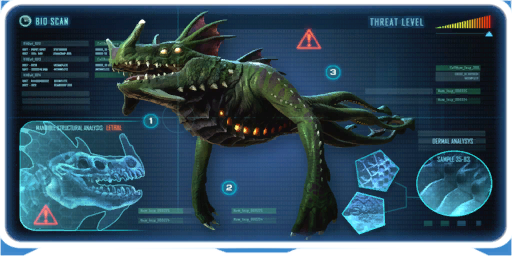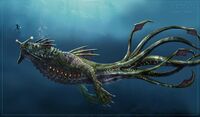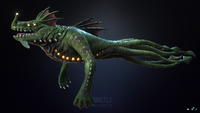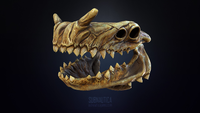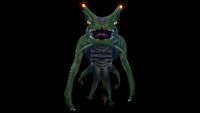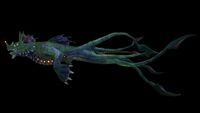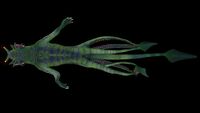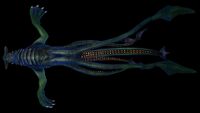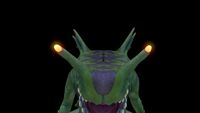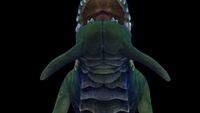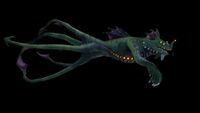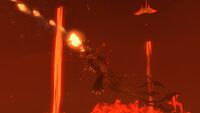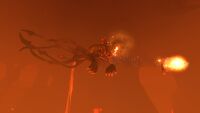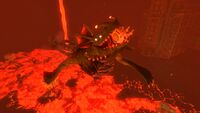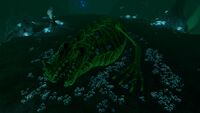Sea Dragon Leviathan: Difference between revisions
No edit summary Tag: rte-wysiwyg |
No edit summary Tag: rte-source |
||
| Line 28: | Line 28: | ||
==Data Bank Entry== |
==Data Bank Entry== |
||
<tabber> |
|||
Sea Dragon Leviathan= |
|||
{| class="article-table sortable" style="width: 100%;" border="0" cellpadding="1" cellspacing="1" |
{| class="article-table sortable" style="width: 100%;" border="0" cellpadding="1" cellspacing="1" |
||
|- |
|- |
||
| Line 38: | Line 40: | ||
# Forearms:<br />Evolutionarily distinct forearms are used for both propulsion and manipulation of objects. Finding suggests evolutionary divergence from other species on the planet many generations ago. The sea dragon may be one of the oldest species encountered so far.<br /> |
# Forearms:<br />Evolutionarily distinct forearms are used for both propulsion and manipulation of objects. Finding suggests evolutionary divergence from other species on the planet many generations ago. The sea dragon may be one of the oldest species encountered so far.<br /> |
||
# Tentacles:<br />Seven tentacles provide unparalleled speed; the scanned specimen measured 112m in length. |
# Tentacles:<br />Seven tentacles provide unparalleled speed; the scanned specimen measured 112m in length. |
||
| Line 52: | Line 55: | ||
Assessment: Extreme threat |
Assessment: Extreme threat |
||
|} |
|} |
||
|-| |
|||
Sea Dragon Leviathan Skeleton= |
|||
<div class="MainPageBox">Entry given for scanning the Sea Dragon Leviathan Skeleton at the Junction.</div> |
|||
{| style="width: 100%;" class="article-table sortable" border="0" cellpadding="1" cellspacing="1" |
|||
|- |
|||
! class="unsortable" style="width: 100%; text-align: center;" | |
|||
|- |
|||
| style="text-align:left; font-size:12px;" | |
|||
A semi-intact skeletal structure belonging to an unidentified leviathan. |
|||
1. Head Trauma:<br /> |
|||
There is clear evidence of physical trauma to the head. The damage is so severe it must have been received shortly before death, somewhere nearby, likely caused by high speed collision with a solid object. |
|||
2. Age:<br /> |
|||
The skeleton has been well-preserved, but calcium decay suggests an approximate time of death around one thousand years ago. Bone growth suggests the creature itself was in the egg-laying stage of its lifecycle. |
|||
|} |
|||
|-| |
|||
Specimen Research Data= |
|||
<div class="MainPageBox">Entry given for downloading a Data Terminal in the Disease Research Facility.</div> |
|||
{| style="width: 100%;" class="article-table sortable" border="0" cellpadding="1" cellspacing="1" |
|||
|- |
|||
! class="unsortable" style="width: 100%; text-align: center;" | |
|||
|- |
|||
| style="text-align:left; font-size:12px;" | |
|||
<poem>This device catalogues information on the organisms contained at this facility prior to the bacterium's release into the ecosystem. A number of entries have been translated. |
|||
Garryfish: |
|||
Shows no immunity to infection - death commonly occurs within 4 days. Does show limited symptom remission on exposure to emperor stomach enzymes, but symptoms quickly recur. |
|||
Sea Dragon Embryos: |
|||
Adult specimen too large to study in containment. Egg specimens acquired from nesting site. Embryos show no signs of immunity - death commonly occurs within 3 weeks. Small sample of eggs has been retained for continued, high priority research on leviathan hatching mechanisms. |
|||
Peeper: |
|||
Shows no immunity to infection. Shows advanced learning behaviors. Shows some capacity to transmit enzymes to other specimens. |
|||
Unidentified Leviathan: |
|||
The closest translation of the alien symbol for this specimen is 'sea emperor'. Bone samples from deceased leviathan specimens indicate some potential for carar immunity. Single specimen captured for study at purpose-built emperor containment facility, constructed in volcanic region at depth 1200m. |
|||
PDA Assessment: While it is unlikely that the emperor specimen is still contained within the facility described, it may be possible to acquire there further data on their attempts to develop a vaccine.</poem> |
|||
</tabber> |
|||
==Gallery== |
==Gallery== |
||
| Line 99: | Line 142: | ||
* Several [[Skeletal Remains|Reaper Leviathan skeletons]] can be seen in the Inactive Lava Zone, they came to be here because of '''Sea Dragons''' that came to the surface in order to hunt, due to a lack of food in their native biomes. |
* Several [[Skeletal Remains|Reaper Leviathan skeletons]] can be seen in the Inactive Lava Zone, they came to be here because of '''Sea Dragons''' that came to the surface in order to hunt, due to a lack of food in their native biomes. |
||
* Its appearance is similar to [http://pacificrim.wikia.com/wiki/Otachi_(Kaiju) Otachi], a Kaiju from the film Pacific Rim. |
* Its appearance is similar to [http://pacificrim.wikia.com/wiki/Otachi_(Kaiju) Otachi], a Kaiju from the film Pacific Rim. |
||
* |
* |
||
*The '''Sea Dragon Leviathan''' was named by the [[Precursor Race|Precursors]], this makes it one of the few species to be so. |
*The '''Sea Dragon Leviathan''' was named by the [[Precursor Race|Precursors]], this makes it one of the few species to be so. |
||
Revision as of 02:40, 4 July 2017
Template:Class 2 FaunaThe Sea Dragon Leviathan is a colossal fauna species. It is the largest aggressive creature of Subnautica, and the second largest overall. There are a total of three Sea Dragon Leviathans on the map; two in the Inactive Lava Zone and one in the Lava Lakes.
Appearance
The Sea Dragon Leviathan's body mostly resembles the Sea Emperor Leviathan, albeit slightly smaller, slimmer in design, and is dark green in color, along with purple accents on its webbed limbs and head. It has protective plates on the underside of its body that start at the neck and run down to where the tentacles begin. Many of its body parts are adorned or spotted with orange bioluminescent glows, and many small spines line its lower jaw and arms.
The head of the creature is stout and reptilian, possessing two pairs of glowing orange eyes with white pupils, a crack-like pattern spreads from the pupils to the rest of the eye. The mouth contains a pink tongue and a thirty two large teeth, visible even when the mouth is closed. The tip of the snout features two short, green protrusions with orange glowing tips. It also has a second set of larger fin-like protrusions beneath its lower jaw. Along the side of its body runs two long, trails of small hollows that emit orange bioluminescent glows. It has two long forearms ending with webbed, four digited hands; each digit ends with a claw that is approximately equal in size to the player's entire body. A large sail sits on the creature's back, just below the shoulders. Its rear-side consists of seven tentacles, also lined with orange spots, and ending with small tentacular clubs, the largest tentacle being surrounded by the six smaller ones.
Behavior
The Sea Dragon Leviathan uses its arms and tentacles to swim in the water at great speed. Just being in close proximity to the Sea Dragon will cause the player or Prawn Suit to be jostled. It will attack the player with its arms if they are on either side of its front body by swatting them away and dealing 40 damage to the player. If the Sea Dragon Leviathan attacks the player with its mouth, it will swallow the player, killing them instantly. Occasionally, the Sea Dragon Leviathan will open its mouth wide and fire a molten rock at its target as a projectile attack. The Sea Dragon Leviathan is also capable of firing a barrage of small "fireballs" covering a wide area.
The Sea Dragon Leviathan will attack the Cyclops by slamming it with its arms with considerable force, often leaving the Cyclops upside down or on its side.
The Sea Dragon Leviathan can deal massive damage to a Prawn Suit very quickly; the swat attack does 13 damage to the suit, the Sea Dragon Leviathan also has the ability to grab the vehicle in its mouth and deal 10-20% damage before releasing it; it often swats immediately after. The meteor attack can do between 24% and 48% damage to the vehicle and a sustained barrage of small fireballs can deal devastating damage to the Prawn Suit.
When the Sea Dragon Leviathan is exposed to damage, it will flinch and commonly, if the Player is close, it will swat them away dealing large amounts of damage to the Player if they aren't in any Vehicles.
Story
|
Spoiler alert: The following section contains story related material. |
|---|
|
A little under a thousand years ago, a Sea Dragon Leviathan Egg was taken by the Precursors and contained within the Disease Research Facility for testing, however, the parent Sea Dragon pursued the Precursors back to the facility and laid waste to it, resulting in the Carar bacterium being released onto Planet 4546B, causing the Precursors to put the planet into quarantine. The skeleton of this Sea Dragon Leviathan can be found near the Disease Research Facility, having suffered massive head trauma from the attack. |
Audio
<soundcloud url="https://soundcloud.com/kamakazi/seadragon" height="166" width="100%" class="soundCloud"></soundcloud>
Data Bank Entry
<tabber> Sea Dragon Leviathan=
|
A colossal aquatic species with reptilian features. It appears to have evolved to consume molten minerals, and expel these materials at its prey.
Assessment: Extreme threat |
|-| Sea Dragon Leviathan Skeleton=
|
A semi-intact skeletal structure belonging to an unidentified leviathan. 1. Head Trauma: 2. Age: |
|-| Specimen Research Data=
- Sea Dragon exoSuitAttack Anim
Animation for biting down on the Prawn Suit.
- Sea dragon combo 01
Various animations without texture.
- Sea dragon combo 02
Various animations with texture.
- Sea Dragon breath attack 01
Animations for breathing fire.
- SN SeaDragonFireBreathVortex 01
Effects for breathing fire and the vortex attack.
- SN SeaDragon 02-0
Completed in-game effects for breathing fire and meteor attack.
Concept Art=
Sea Dragon Leviathan Concept Art
Other=
</tabber> For a more complete gallery, visit Sea Dragon Leviathan/Gallery
Trivia
- The sounds of the Sea Dragon Leviathan were created by combining real sounds from a bull, an elephant and a tiger.
- Several Reaper Leviathan skeletons can be seen in the Inactive Lava Zone, they came to be here because of Sea Dragons that came to the surface in order to hunt, due to a lack of food in their native biomes.
- Its appearance is similar to Otachi, a Kaiju from the film Pacific Rim.
- The Sea Dragon Leviathan was named by the Precursors, this makes it one of the few species to be so.
Lua error in package.lua at line 80: module 'Dev:Navbox' not found.
|
<poem>This device catalogues information on the organisms contained at this facility prior to the bacterium's release into the ecosystem. A number of entries have been translated. Garryfish: Shows no immunity to infection - death commonly occurs within 4 days. Does show limited symptom remission on exposure to emperor stomach enzymes, but symptoms quickly recur. Sea Dragon Embryos: Adult specimen too large to study in containment. Egg specimens acquired from nesting site. Embryos show no signs of immunity - death commonly occurs within 3 weeks. Small sample of eggs has been retained for continued, high priority research on leviathan hatching mechanisms. Peeper: Shows no immunity to infection. Shows advanced learning behaviors. Shows some capacity to transmit enzymes to other specimens. Unidentified Leviathan: The closest translation of the alien symbol for this specimen is 'sea emperor'. Bone samples from deceased leviathan specimens indicate some potential for carar immunity. Single specimen captured for study at purpose-built emperor containment facility, constructed in volcanic region at depth 1200m. PDA Assessment: While it is unlikely that the emperor specimen is still contained within the facility described, it may be possible to acquire there further data on their attempts to develop a vaccine.</poem> </tabber> Gallery<tabber> Screenshots=
|

